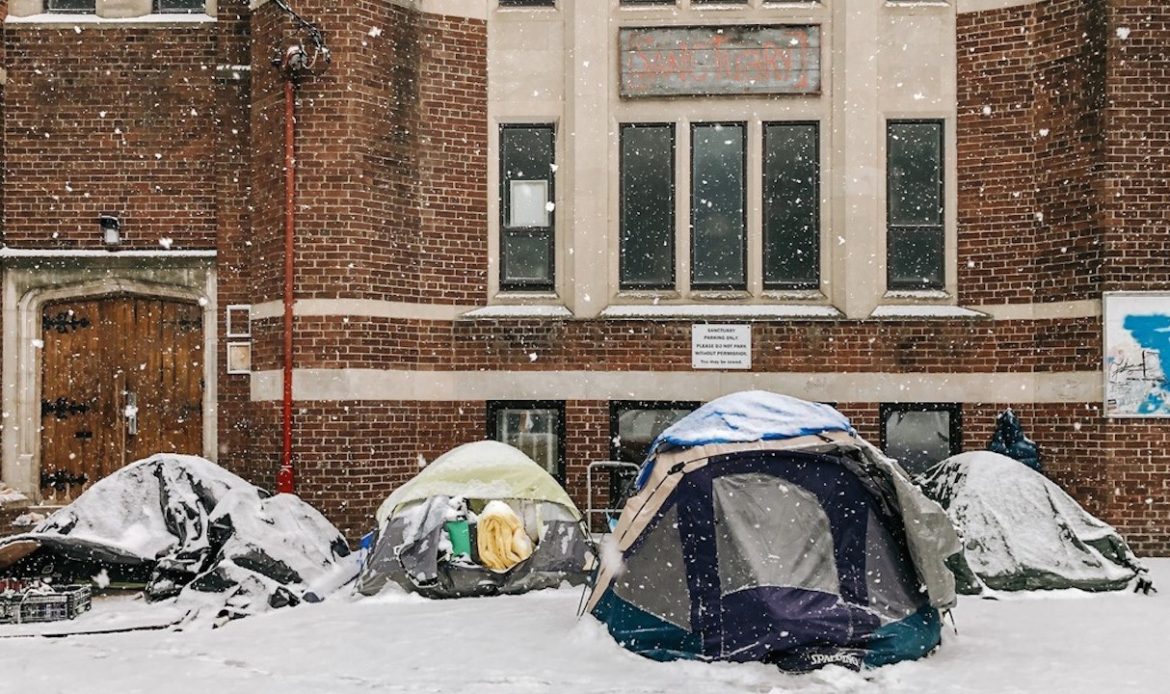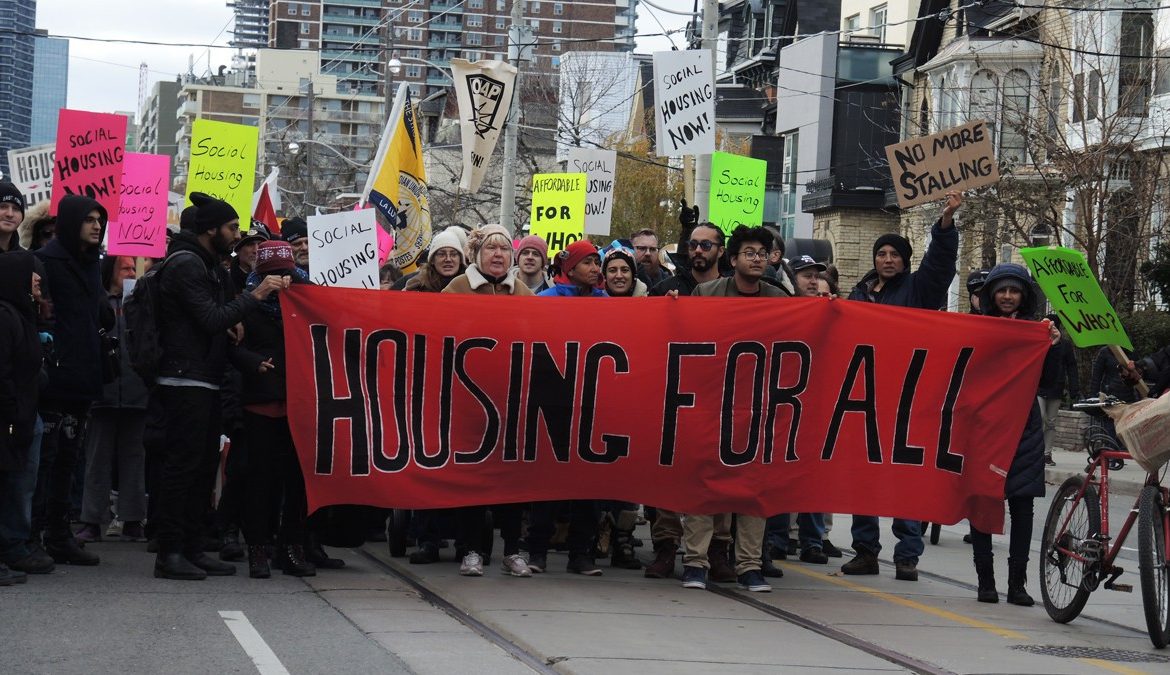Combatting Homelessness with a House of Cards

An indictment of Toronto’s shelter system and a call to action for the Tory Administration
On January 13th, 2022, the Toronto Star reported that the Toronto shelter system was filled to the brim with residents seeking shelter from the cold and cases of the COVID-19 Omicron variant. Reasons for this declaration include COVID-19 cases amongst residents and the limited staff due to poor PPE provisions and vaccination rates, lack of healthcare expertise among staff, and frigid cold temperatures driving up demand for shelter services.
Following this announcement, mainstream media outlets have primarily pointed to COVID-19 and its subsidiary factors as the cause for the crisis’ peak; however, it’s naive to claim that COVID-19 bears the sole responsibility. Rather, COVID-19 has merely magnified the pre-existing systemic issues that have plagued the industry—issues that shelter workers, residents, and advocates have tried to eradicate to no avail for years. It has become impossible to ignore the crisis as the shelter system’s house of cards is one wayward wind away from collapse.
This article strives to fill a gap within the mainstream media coverage by examining the shelter system through a historical lens and using that knowledge to make an indictment of the system, address the government’s poor response to the crisis, and suggest ways to transformatively rebuild.
Government neglect regarding the Toronto shelter system has been a long, public, and well-documented issue; yet, the city and many of its residents have come down with a cyclical case of historical amnesia since the 1980s.
While advocacy against homelessness has always existed, the movement began to pick up in the 1980s after urban restructuring had engendered a significant change in the number and demographics of what was called the “new homeless.” This early movement was spearheaded by the Single Displaced Persons Project (SDPP): a network of churches, social service members, and philanthropists that fought for those most marginalised in Toronto by attacking failures in economic systems.
As this network of activists and organizations grew into an anti-homelessness movement, their primary focus was addressing rapidly emerging neoliberal and entrepreneurial patterns in the city that are now weaved into the fabric of Toronto identity. They fought for a long-term, affordable housing system, not an emergency shelter system. Their dedicated fighting resulted in the city’s first-ever provincially funded subsidised housing program. It was a historic win for activists and homeless individuals, so naturally, it was walked back in 1993 when the federal government reduced funding for affordable housing and gave all jurisdiction to the provincial government over social funding. With the recent recession, the late-90s set the stage for a rapid increase in both government-wide austerity politics and the emergence of the “real estate state” in Toronto.
This term, coined by Samuel Stein, describes the dominant urban planning discourse that is predicated upon the sole interests of developers and increasing real estate values; thereby, engendering the gentrification and luxury condo-building that is increasingly ubiquitous in all major global cities.
These factors plunged homelessness into the grimmest figures Toronto had seen in decades and it is this entangled web of performative actions, neoliberal politics, and government neglect that this millennium’s activists and organizations have been striving to unravel.

Dr. David Roberts moved to Toronto 14 years ago after working within the Seattle shelter system and now serves as the director of the University of Toronto’s Urban Studies program and advocates for Toronto’s downtown east communities. In a conversation with The Innis Herald, he argued that, as long as he has been here, not only has there never been enough shelter spaces in Toronto, but the shelters that do exist vary greatly in quality and security.
“Some shelters are just as bad as being in a large open space with beds. There’s sometimes violence, there’s definitely been the spread of disease… It’s that sort of knife’s edge in terms of providing necessary supports, but not being underfunded or beyond capacity.”
The problems of the shelter systems have been crystallized in this devastating cycle that mirrors the issues of the past. In 2020, the Toronto Star published an editorial that could have been stolen from the original SDPP’s manifesto on the importance of building houses, not shelters, for the homeless. In 2003 and 2013, the City of Toronto voted to keep shelter capacities under 90%, yet shelters are as overcrowded as they were 30 years ago, if not more. Finally, CBC reported in 2016 that activists rallied together a petition to John Tory to open large armouries to provide additional winter shelter, prevent overcrowding, and limit the spread of a viral outbreak.
Cyclical historical amnesia is one powerful drug.
COVID-19 has undoubtedly exposed the shelter system’s faultlines, but to claim this virus as the sole reason for its impending collapse erases the decades of activism, struggle, and systemic discrimination against Toronto’s unhoused population.
Regarding the contemporary crisis, a City of Toronto press release expressed “the City’s commitment to ensuring the safety of people experiencing homelessness remains unwavering…Throughout the pandemic, the City has prioritised the health and safety of people experiencing homelessness in shelters and outdoor settings and will continue to do so, especially now, in light of the Omicron variant.”
These baseless statements are a lot more palatable than the sour reality. According to City of Toronto data, the death count of unhoused people has been steadily increasing since the pandemic began. In 2020, there were 78 shelter resident deaths; in 2021, that number nearly doubled to 132. Furthermore, according to a City of Toronto report, while the average life expectancy of a housed Toronto resident is 81 years old, the average life expectancy of a shelter resident is 47. Finally, in a recent press release, media representatives for the Tory administration boasted about Toronto’s shelter system being the largest in Canada with space for 7,200 residents. They fail, however, to mention that the shelter system is concentrated in the southeast and southwest corners of the city, therefore, limiting access to residents, and Toronto is home to 7,350 recorded homeless residents with hundreds to thousands of additional unrecorded homeless or precariously housed people.
These grim statistics are particularly concerning for Toronto’s BIPOC, LGBTQAI2S+, and refugee communities who are more likely to experience homelessness. To capture these statistics and still believe that Toronto ensures an “unwavering and prioritised commitment to the health and safety of homeless people” is a reflection of the municipal government’s disregard for unhoused people’s lives and the shelter workers maintaining the shelter system’s feeble structural integrity.
Short and long-term solutions are needed to repair the fatal foundational fissures in the shelter system. Thanks to the relentless fight of community advocates, the Tory administration has begun to meet short-term solutions. Since the shelter system’s collapse in early January 2022, the city has implemented four primary strategies to support shelters, including temporarily expanding the system by occupying community centres and 26 other large venues, opening four warming centres facilitated by the city’s Streets to Home Program, and providing mobile vaccine clinics and N95 masks to shelters in an attempt to slow the spread of the Omicron variant. While these short-term solutions will address the overcrowding and high COVID-19 transmissions, these programs are band-aids on systemic bullet wounds.
Regarding long-term public health and safety concerns, Dr. Roberts offers a solution that, while costly, is likely to address long-term disease prevention that has long plagued the system. Roberts suggests, “[Things like plexiglass around beds and robust cleaning protocols] don’t actually solve the biggest challenge of COVID, which is that it’s airborne and doesn’t sit on surfaces very long… From my understanding, more leading research is about cleaning air through ventilation systems and filters… as a mechanism to reduce the spread”.
“Many of these shelter buildings were not built to house people… It really would take a significant investment but it’s likely that that investment would not just prevent the spread of COVID, but also reduce the spread of cold and flu and all kinds of other sorts of indoor airborne diseases and toxins.”
Moving away from public health solutions, the City of Toronto and the Ontario Government must finally answer the cries that started with SDPP in the 1980s: we don’t need more shelters, we need more affordable houses and fewer luxury condos. According to the city’s 2021 Budget for Shelter, Support, and Housing Administration, the Tory administration’s operating budget for housing services will continue to decrease by approximately $100 million from 2021 to 2023.
The Ontario Government must intervene to aid the municipal government’s funding plans. Waitlists can no longer be backed up, affordable housing can no longer be surrendered to luxury condo development downtown, and the Toronto Police should no longer compose the largest section of the city budget—an institution that has historically been used to control homeless populations.
Furthermore, both governments must address the colonial and neoliberal socioeconomic structures that continually discriminate against BIPOC, LGBTQAI2S+, and refugee communities. To quote Toronto Indigenous Harm Reduction, “Indigenous people cannot be homeless on their homelands.”
We have historically combatted homelessness in Toronto by building houses of cards. While these measures look like solutions from the outside, they crumple under scrutiny and have failed the communities they “unwaveringly serve” for decades. It should not have come to this, but one can only hope that the catastrophic consequences of the mishandling of COVID-19 within the shelter system will finally force governments to look at how Canada is failing their homeless communities, listen to advocate’s pleas, and create transformative changes.